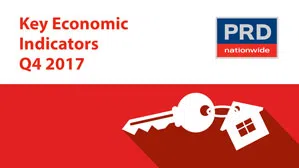PRD's Key Economic Indicators Q4 2017

Key Findings
- Unaffordability growth is higher in Victoria than New South Wales. Over the past 12 months (to June 2017) home affordability growth in Victoria decreased by 2.0%, more than New South Wales’s 1.5%. Victoria’s first home buyer loans also decreased by 10.1%, higher than New South Wales’ decrease of 3.4%.
- Tasmania has had the largest decrease in first home buyer loans across the country, down by 17.6% over the past 12 months. Tasmanian first home buyers are officially being priced out.
- The Northern Territory leads in home loan affordability growth over the past 12 months (to June 2017), at 8.6% (49.2 index points), while the once affordable South Australia becomes increasingly unaffordable.
- Property demand will grow the most in Queensland, as nett migration figures increased by an exponential 54.7%, to 15,736 in March 2017. This is the highest percentage growth across all Australian states, which when combined with cooling measures in dwelling approvals (by 5.3% over the past 12 months (to September 2017)) indicates more opportunities for developers to build new stock.
Get the full report
The Northern Territory leads the way with 8.6% improved affordability
The Northern Territory (NT) has been leading home loan affordability growth over the past 12 months (to June 2017), at 8.6% (49.2 index points), while the once affordable South Australia becomes more unaffordable. Tasmania had the largest decrease in first home buyer loans across the country, down by 17.6% over the past 12 months.
Consumer sentiment made a brief appearance in the positive range in October 2017, at 101.4 index points
Consumer sentiment is a key indicator of the general population’s confidence in the economy, whereby a higher index point reading suggests consumers are more willing to spend rather than save. Consumer sentiment made a brief appearance in the positive range in October 2017, at 101.4 index points. However, this has dipped to below positive levels again in November 2017 (to 99.7 index points). Although this is not the lowest point for consumer sentiment in 2017, it is a 1.5% decrease over the past 12 months.
The standard variable loan remained stable at 5.2% and consumer price inflation decreased to 1.8 index points this quarter, meaning that there should be more household income available to families. This should assist in building consumer confidence over the next few months.
Weekly median income has increased in all states
The Australian weekly median income recorded at $1,696 in June 2017, which is an increase of 2.2% over the past 12 months. Weekly median income increased in all states, with South Australia leading the way for 2 consecutive quarters (March and June 2017) – increasing by 3.7% to $1,553 per week. This is followed by Victoria (increasing by 3.0% to $1,648 per week) and a 3rd place tie between Queensland (by 2.4% to $1,651 per week) and Tasmania (by 2.4% to $1,394).
Combined with a declining unemployment rate across most states (with the exceptions of Queensland and the Northern Territory) this should result in an increase in disposable household income. Good news for any industry that relies upon the society’s propensity to consume/buy goods and services.
Affordability for all, in particular first home buyers, continues to be a hot topic and a key concern
Affordability for all, in particular first home buyers, continues to be a hot topic and a key concern. Over the past 12 months the Australian Home Loan Affordability Indicator has decreased by 0.9%, to 31.8 index points. Interestingly, Tasmania (once hailed to be one of the most affordable states in the country), has had a decrease in affordability – by 0.5% to 41.9 index points. This is further confirmed by a decrease of 17.6% in first home buyer loans, the largest decrease among all states.
What are PRD’s Key Economic Indicators?
The PRD Q4 2017 Key Economic Indicators provide consumers with a quick snapshot of the current state of affairs from an economic and property perspective.
The PRD Key Economic Indicators cover both national and state-level data, comprising of:
- Number of loans to first home buyers
- Home loan affordability index
- Number of dwelling approvals
- Consumer sentiment index
- Standard variable loan
- Consumer price index
- Unemployment rate
- Weekly family income
- Nett migration
Related articles
View PRD's Key Economic Indicators for Q3 2017
View PRD's Key Economic Indicators for Q2 2017
View PRD's Key Economic Indicators for Q1 2017
Find property research & more in PRD's Research Hub








